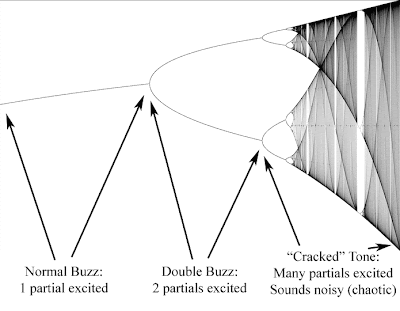Greetings and happy holidays! First I have to apologize, because I still haven't included score previews for my works. The links are still empty. However, I'm updating my website before winter quarter kicks in again, when I will be slammed with 18th century counterpoint instruction and a digital signal processing class, not to mention a huge project for percussionist Dustin Donahue and a mobile piece (after John Cage and Marcel Duchamp) entitled Canned Chance.
It has been a busy holiday break for me, traveling between St. Louis and San Diego, while trying to finish a trumpet piece for the International Contemporary Ensemble's CalIT2 residency in 2011. Peter Evans will record my piece, which I'm calling Blue Sky Catastrophe, after a particular kind of bifurcation behavior in dynamical systems. The piece has been fun to write because trumpet is my native instrument, and it has allowed me to further refine my technique on the instrument, while exploring relatively new ground in brass writing.
The piece is a study in double-buzz multiphonics - one difficult but rewarding method of achieving multiphonics on a brass instrument (the other method is singing and playing simultaneously). I would posit that double buzz can be considered the "true" multiphonic brass technique because the same lip-reed/air column acoustic system is responsible for both pitches produced by the instrument.
Exciting two different partials in the cylindrical bore of the instrument by vibrating the top and bottom lips at different speeds is the key in this case. There is feedback from the vibrating air column back to the lips, which seems to contribute to the unpredictable nature of double-buzz multiphonics. When first learning to produce them, there is a tendency to flop back and forth between partials, with only one excited at any one time. However, with practice, a trumpet player can "ride" the system, preventing it from snapping into a single stable state, usually with two adjacent partials excited at a time (occasionally with a harsh "grinding" noise, presumably an amplified sum or difference tone).
I would hypothesize that the acoustic system involved is dynamical, and that it has bifurcation properties, though probably unlike the mathematical Blue Sky Catastrophe itself (but what a great name!). Instead it is probably similar to something like the bifurcation properties of the Logistic Map, with its bifurcation diagram below. Normal buzz is characterized by one stable state excited, double buzz by two stable states excited, and "cracked" tone by many stable states (perceived as noise). Of course, this is all speculation, but it seems intuitively plausible.
Wednesday, December 29, 2010
Blue Sky Catastrophe; Score Preview Links Still Empty
Subscribe to:
Post Comments (Atom)
No comments:
Post a Comment